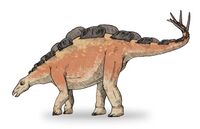Earth:Lianmuqin Formation
From HandWiki
| Lianmuqin Formation Stratigraphic range: Valanginian-Albian ~140–100 Ma | |
|---|---|
| Type | Geological formation |
| Unit of | Tugulu Group |
| Underlies | Donggou & Kumutake Formations |
| Overlies | Shengjinkou Formation |
| Thickness | 213–360 m (699–1,181 ft) |
| Lithology | |
| Primary | Mudstone, siltstone |
| Location | |
| Coordinates | [ ⚑ ] : 46°00′N 85°48′E / 46.0°N 85.8°E |
| Paleocoordinates | [ ⚑ ] 45°00′N 81°54′E / 45.0°N 81.9°E |
| Region | Xinjiang |
| Country | |
| Extent | Junggar Basin |
| Type section | |
| Named for | Lianmuqin |
| Lua error in Module:Location_map/multi at line 27: Unable to find the specified location map definition: "Module:Location map/data/China Xinjiang Northern" does not exist. | |
The Lianmuqin Formation,[1] also transcribed as Lianmugin Formation,[2] and Lianmuxin Formation,[3] is an Early Cretaceous geologic formation composed of "interbedded red green and yellow variegated mudstones and siltstones".[4][5] Dinosaur remains have been recovered from it.[6]
The formation is named after Lianmuqin Town in Shanshan County, Xinjiang.
Vertebrate paleofauna
Dinosaurs
| Dinosaurs of the Lianmuqin Formation | ||||||
|---|---|---|---|---|---|---|
| Genus | Species | Location | Stratigraphic position | Material | Notes | Images |
| Asiatosaurus[7] | A. mongoliensis[7] | |||||
| Kelmayisaurus[7][8] | K. petrolicus[7] | "Maxilla and dentary."[9] | ||||
| Xinjiangovenator | X. parvus | "Tibia [and] phalanges."[10] | Formerly thought to be a representative of Phaedrolosaurus ilikensis.[7] | |||
| Phaedrolosaurus | P. ilikensis | "tooth"[11] | ||||
| Psittacosaurus[7] | P. xinjiangensis[7] | |||||
| Tugulusaurus[7] | T. faciles[7] | "Hindlimb, rib, [and a] vertebral centrum."[12] | ||||
| Wuerhosaurus[7] | W. homheni[7] | "Partial skeleton."[13] | ||||
Pterosaurs
| Pterosaurs of the Lianmuqin Formation | ||||||
|---|---|---|---|---|---|---|
| Genus | Species | Location | Stratigraphic position | Abundance | Notes | Images |
| Dsungaripteridae indet.[14] | indeterminate[14] | Not referable to Lonchognathosaurus or Dsungaripterus; likely a new taxon.[14] | ||||
| Dsungaripterus | D. weii[15] | |||||
| Noripterus | N. complicidens[16] | |||||
| Lonchognathosaurus | L. acutirostris[16] | Possible junior synonym of Dsungaripterus weii.[17] | ||||
Crurotarsans
| Name | Species | Location | Stratigraphic position | Abundance | Notes | Images |
|---|---|---|---|---|---|---|
| Edentosuchus | E. tienshanensis[18] |
See also
- List of dinosaur-bearing rock formations
- List of stratigraphic units with few dinosaur genera
References
- ↑ "Re: Kelmayisaurus a carcharodontosaurid". dml.cmnh.org. http://dml.cmnh.org/2011Apr/msg00306.html.
- ↑ Lianmugin Formation at Fossilworks.org
- ↑ I. G. Danilov, J. F. Parham (2007). "The type series of "Sinemys" wuerhoensis, a problematic turtle from the Lower Cretaceous of China, includes at least three taxa". Palaeontology 50 (2).
- ↑ Lucas, Spencer G, Chinese Fossil vertebrates, Pp. 158-159, New York, Columbia University Press, ISBN:0-231-08483-8.
- ↑ Lucas, S.G. (2001). Chinese Fossil Vertebrates. Columbia University Press. p. 158. ISBN 9780231084833. https://books.google.com/books?id=svFUrN8xBpwC. Retrieved 2015-01-05.
- ↑ Weishampel et al., 2004, pp.517-607
- ↑ Jump up to: 7.00 7.01 7.02 7.03 7.04 7.05 7.06 7.07 7.08 7.09 7.10 "48.5 Xinjiang Uygur Zizhiqu, People's Republic of China; 1. Tugulu Group," in Weishampel, et al. (2004). Page 567.
- ↑ "A reassessment of Kelmayisaurus petrolicus, a large theropod dinosaur from the Early Cretaceous of China". http://www.app.pan.pl/archive/published/app56/app20100125_acc.pdf.
- ↑ "Table 4.1," in Weishampel, et al. (2004). Page 73.
- ↑ "Table 4.1," in Weishampel, et al. (2004). Page 78.
- ↑ Z.-M. Dong. (1973). [Dinosaurs from Wuerho]. Memoirs of the Institute of Vertebrate Paleontology and Paleoanthropology, Academic Sinica 11:45-52. [Chinese]
- ↑ "Table 4.1," in Weishampel, et al. (2004). Page 77.
- ↑ "Table 16.1," in Weishampel, et al. (2004). Page 345.
- ↑ Jump up to: 14.0 14.1 14.2 "Pterosaur remains from the Lower Cretaceous Lianmuxin Formation (upper Tugulu Group) of the southern Junggar Basin (NW China)". Historical Biology: An International Journal of Paleobiology 34 (2): 312–321. 2021. doi:10.1080/08912963.2021.1910819.
- ↑ "Re: The timing of stegosaur extinction". dml.cmnh.org. http://dml.cmnh.org/2005Feb/msg00427.html.
- ↑ Jump up to: 16.0 16.1 Barrett, P.M., Butler, R.J., Edwards, N.P., & Milner, A.R. Pterosaur distribution in time and space: an atlas. p61-107. in Flugsaurier: Pterosaur papers in honour of Peter Wellnhofer. 2008. Hone, D.W.E., and Buffetaut, E. (eds). Zitteliana B, 28. 264pp.[1]
- ↑ Andres, B.; Clark, J. M.; Xing, X. (2010). "A new rhamphorhynchid pterosaur from the Upper Jurassic of Xinjiang, China, and the phylogenetic relationships of basal pterosaurs". Journal of Vertebrate Paleontology 30 (1): 163–187. doi:10.1080/02724630903409220. http://doc.rero.ch/record/31614/files/PAL_E956.pdf.
- ↑ Jinling Li (July 1985). "A revision of Edentosuchus tienshanensis Young from the Tugulu Group of Xinjiang Autonomous Region". Vertebrata PalAsiatica 23 (3): 196–206. http://www.paleoglot.org/files/Li_85a.pdf. Retrieved 2015-01-05.
Bibliography
- Weishampel, David B., ed (2004). The Dinosauria (2nd ed.). Berkeley: University of California Press. pp. 1–880. ISBN 0-520-24209-2. https://books.google.com/books?id=vtZFDb_iw40C. Retrieved 2019-02-21.
 |



